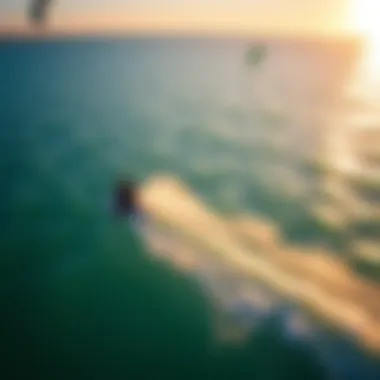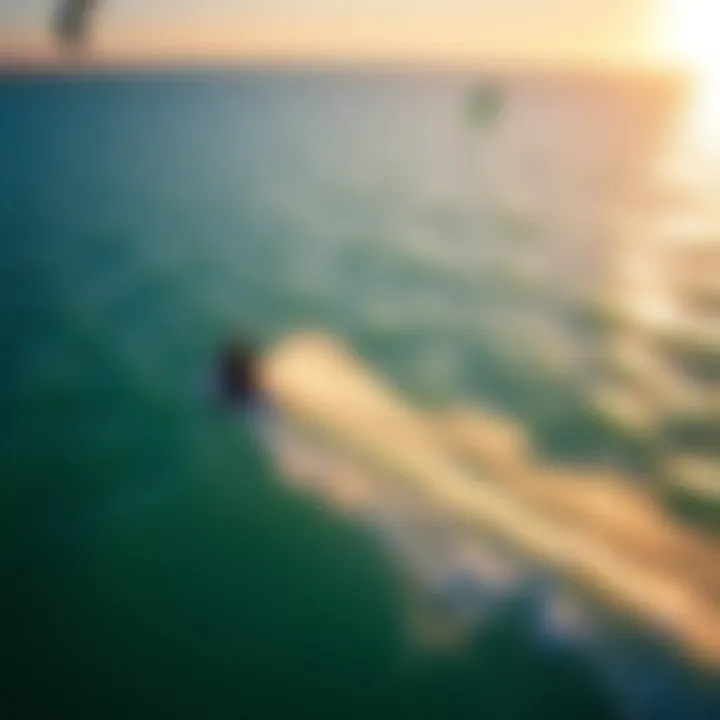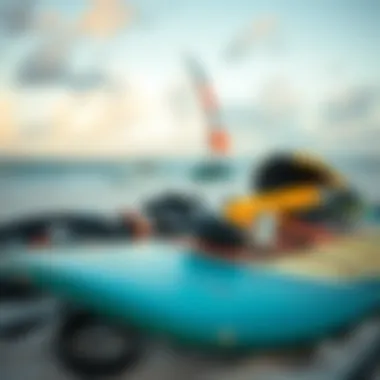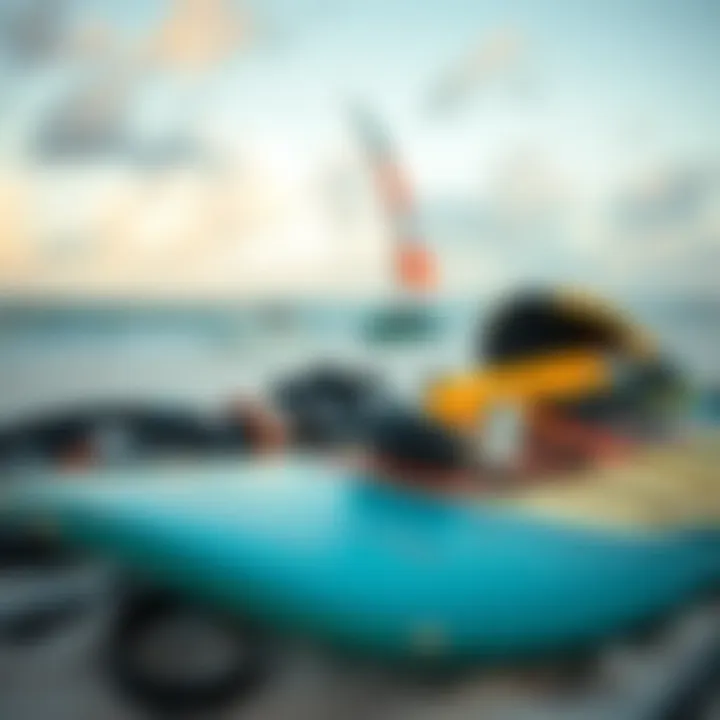Discovering Kiteboarding in the Florida Panhandle


Intro
The Florida Panhandle stretches along the northern Gulf Coast, merging stunning landscapes with a rich tapestry of culture. This unique region, shaped by its geographical idiosyncrasies, makes it a prime destination for kiteboarding. With miles of sandy beaches and consistent winds, the Panhandle offers kiteboarding enthusiasts—whether novice or veteran—a playground that’s begging to be explored.
In this extensive guide, we delve into the nitty-gritty of kiteboarding in the area. We’ll visit essential locales, dissect weather patterns, lay out safety protocols, and recommend the gear that will take your experience from mediocre to stellar. More than just a landing spot for kiteboarding, the Panhandle represents a lifestyle infused with adventure and exploration.
For anyone looking to ride the winds and conquer the waves, understanding this region's contours and quirks can transform an ordinary outing into an unforgettable escapade.
Geography of the Florida Panhandle
Understanding the geography of the Florida Panhandle is essential for anyone interested in kiteboarding and the natural beauty of the region. The area's unique layout not only shapes the activities available but also influences the climate and local ecosystems. Kiteboarders will find that familiarizing themselves with this environment can markedly enhance their experience, allowing for optimal planning and enjoyment.
Defining the Panhandle
The term "Panhandle" refers to the elongated, narrow strip of land in the northwestern part of Florida, projecting into the Gulf of Mexico. It stretches from Alabama in the west to Georgia in the east, creating a natural border that defines this unique region. The shape contributes to its cultural ambience, as the area exhibits a blend of Southern charm and coastal flair.
When speaking about the Florida Panhandle, one must acknowledge the diversity of its communities, including cities like Pensacola and Tallahassee. These hubs not only serve as gateways to the stunning landscapes but also as cultural melting pots where visitors can immerse themselves in local traditions.
Topographical Features
The Florida Panhandle boasts a host of striking topographical features that enhance its appeal.
Coastal Dunes
One prominent aspect of the Panhandle's geography is its coastal dunes. These are not merely sandy hills; they act as natural barriers, protecting inland areas from storms and erosion. The dunes are often covered in sea oats, which help stabilize the sand, providing a rich habitat for various wildlife.
The unique characteristic of these coastal dunes lies in their shifting nature—they evolve over time due to wind and water influences. For kiteboarders, this feature brings added interest as the scenery changes with each visit. While the dunes provide a stunning backdrop for kiteboarding, it's worth noting that they can be fragile and should be respected to maintain their beauty and integrity.
Bays and Estuaries
Bays and estuaries are another significant aspect of the Panhandle's geography. Systems like Pensacola Bay and St. Andrew Bay offer calm waters that are perfect for beginners in kiteboarding. The key characteristic of these bodies of water is their rich biodiversity; they serve as critical habitats for both marine and terrestrial species.
These areas also provide ideal conditions for kiteboarding enthusiasts during certain times of the year. They help buffer wind and wave conditions, making for a more temperate riding experience. However, one must be cautious, as shallow areas may present challenges.
Inland Wetlands
The inland wetlands of the Panhandle further complement the region's geography. These areas hold water during rainy seasons, resulting in lush habitats. They effectively filter pollutants and support an array of wildlife, making them vital for ecological balance.
For kiteboarders, the unique feature here is the potential for exploring less conventional spots. While they might not be the first choice for kiteboarding, these wetlands provide an opportunity for adventurers to discover new locations. The wetlands' soft landscapes could pose a risk for equipment; hence, knowledge of the area is important, ensuring a safer and more enjoyable experience.
Climate Overview
The climate of the Florida Panhandle exhibits a humid subtropical pattern that draws enthusiasts for various outdoor activities, kiteboarding included. Understanding seasonal weather patterns can play a critical role in planning a successful trip.
Seasonal Weather Patterns
The seasonal weather patterns demonstrate a mix of distinct seasons that affect kiteboarding opportunities. Summers tend to be hot and humid, while winters are much milder. Notably, spring and fall present the most favorable conditions, as gentle breezes accompany warm temperatures.
This variability in weather means that kiteboarders can find their sweet spot during different seasons, but awareness of potential storms during summer is crucial.
Wind Conditions for Kiteboarding
Wind conditions are a vital element for kiteboarding enthusiasts. The Florida Panhandle experiences consistent sea breezes, especially in warmer months, providing excellent wind for kiteboarding.
The key characteristic to note is the offshore winds that can sometimes create challenging conditions for beginners, so familiarity with local wind patterns is essential to maximize safety and enjoyment.
Temperature Variations
Temperature variations across the region serve as both an advantage and a disadvantage. While summer temperatures can soar above 90°F, the cooler months offer relief, with averages dropping to the 50s and 60s.
This range impacts what equipment kiteboarders should use, as specific kit types work better in cooler or warmer climates. Ultimately, understanding these temperature fluctuations and planning accordingly can lead to more enjoyable sessions on the water.
Key Locations for Kiteboarding
Kiteboarding is not just a hobby; it's a lifestyle, especially in the Florida Panhandle. This region offers a variety of locations that cater to kiteboarders of all skill levels. From thrilling open waters to serene bays, the geography of the Panhandle provides ideal conditions. When choosing a kiteboarding spot, considerations like wind patterns, accessibility, and local amenities can deeply impact the experience. Thus, understanding the best locations plays a fundamental role in enjoying this exhilarating sport.
Specific Kiteboarding Hotspots
Pensacola Beach
Pensacola Beach is a gem for kiteboarders looking for a mix of adventure and relaxation. The beach is renowned for its powdery white sand shores and emerald green waters, providing an appealing backdrop for kiteboarding. The winds at Pensacola Beach tend to be steady, making it a favorable spot for both beginners and seasoned riders.
The key characteristic of this beach is its spaciousness. Kiteboarders can find ample room to launch their kites without worrying about crowding. Additionally, there are plenty of nearby amenities, including rental shops and eateries, ensuring that riders have everything they need for a complete day out.
However, like any other location, Pensacola Beach is not without its challenges. The summer months can see an influx of tourists, which might lead to more crowded waters. Riders should be mindful of maintaining a safe distance from swimmers and other water enthusiasts.
Navarre Beach
Navarre Beach's tranquil atmosphere invites kiteboarders who prefer less crowded conditions. With its pristine beach and open waters, this location is often considered a hidden treasure in the Panhandle. The winds here can vary but are generally favorable for riding, especially during spring and fall months.
A standout feature of Navarre Beach is its long stretches of beach area, which provide multiple launch points. This characteristic enables riders to pick their spot based on wind direction. Since it’s less frequented than some other beaches, it’s an excellent choice for those wanting a peaceful kiteboarding experience.
On the downside, options for amenities like food and equipment rentals might be limited compared to busier beaches, so riders need to come prepared.
Destin
Destin stands out as a bustling center for kiteboarding, attracting a plethora of enthusiasts just like a moth to a flame. The city is famous for its vibrant nightlife, which complements the exhilaration of kiteboarding. The waterways around Destin are often filled with kiteboarders showcasing their skills, making it a lively spot for those who thrive in dynamic environments.
A primary advantage of kiteboarding in Destin is the accessibility of equipment rentals and professional instruction. This makes it an ideal location for beginners looking to take their first steps into the sport. However, the popularity of this beach can lead to congested waters, particularly during peak times.
Grayton Beach
Grayton Beach offers a unique experience that merges local culture with kiteboarding. Known for its quaint charm, the beach is part of the Gulf Islands National Seashore, creating a picturesque setting for riders. The winds here are often ideal, but the beach's narrowness can be a challenge when launching.
A quirky aspect of Grayton Beach is its laid-back vibe, where art and nature interweave through the community. The nearby shops often reflect this through local art, giving visitors a taste of the surfing culture interlaced with environmental awareness. On the downside, the compactness of the area might limit space for launching during crowded times, so kiteboarders need to be aware of their surroundings.


Local Launch Sites
Public Access Points
Public access points are essential for facilitating easy entry to the water. They are designed not just for kiteboarders, but also for the general public, ensuring inclusivity. These points usually come with parking facilities, making them practical choices for visits.
However, a characteristic of public access points is that they can become quite busy, especially on weekends. Anyone looking to kiteboard here must be attentive and patient, as sharing the space with others requires good communication and safety awareness.
Private Launch Areas
Private launch areas can offer perks that public access points often lack. Many resorts and private beaches provide designated zones specifically for kiteboarding, ensuring that there is less interference from swimmers. This can lead to a notably safer riding environment, enhancing the overall experience.
However, accessing these private areas typically comes with fees, whether through daily charges or membership options. Riders should also be considerate of any rules or guidelines established by the property owners.
Considerations for Safety
Safety should always be front and center in kiteboarding. Awareness of the environment, as well as local regulations regarding kiteboarding zones, plays a crucial role in ensuring a secure experience. All riders need to familiarize themselves with the local laws that govern kiteboarding, including permitted areas and any environmental protection guidelines.
Unique features of safety considerations include the importance of monitoring weather conditions and knowing emergency protocols. A comprehensive knowledge of first aid can also be invaluable in case of mishaps. Overall, prioritizing safety can make a significant difference in enjoying the sport without unnecessary risk.
Techniques for Optimizing Your Kiteboarding Experience
Kiteboarding in the Florida Panhandle isn’t just about catching wind and riding waves; it’s an intricate dance with the elements. Understanding various techniques can significantly enhance both the safety and enjoyment of kiteboarding. By honing in on wind patterns, selecting appropriate equipment, and mastering riding techniques, kiteboarders can navigate this beautiful region with increased confidence.
Understanding Wind Patterns
Offshore vs Onshore Winds
Offshore winds blow from land to sea, while onshore winds come from the ocean toward the coast. For kiteboarders, onshore winds are typically more favorable, especially for beginners. Onshore winds provide steady lift and a measure of safety, as they tend to push riders back towards the shore. However, offshore winds can create thrilling conditions for experienced kiters looking to venture further out.
Key characteristic: Onshore winds are generally more reliable and predictable in this region, creating a safer atmosphere for all levels of kiteboarding.
Advantages of Onshore Winds:
- bring a sense of security for less experienced kiteboarders
- easier to ride back to the beach in case of difficulty
Disadvantages of Offshore Winds:
- potential for stronger currents
- increased risk of drifting away from the launch site, which can be daunting should something go wrong.
Tidal Influences
The tides hold a sway over conditions in the Florida Panhandle, shaping where and how effectively one can kiteboard. High tides might flood areas that could normally be ideal for launching. Low tides, on the other hand, can open up expansive areas, revealing sandbars and wider riding zones.
Key characteristic: Tidal movements are particularly important to monitor since they can dictate where you can ride at any given time.
Advantages of Tidal Knowledge:
- better planning for peak riding times
- can create unique riding experiences such as exploring newly exposed areas.
Considerations: Failing to account for the tidal schedule can lead to tricky situations where riders find themselves caught on a sandbar or stranded. You can check tide forecasts on reliable apps or local websites to stay informed.
Local Wind Predictions
A key to successful kiteboarding is knowing how to read the weather. Local wind predictions can vary greatly due to geographical and seasonal shifts. Wind conditions in the Panhandle can change rapidly, making it essential to stay updated. Learning to interpret local forecasts can set kiteboarders up for success on the water.
Key characteristic: Many areas feature microclimates that can yield unpredictable winds, emphasizing the need for real-time data.
Advantages of Using Local Predictions:
- Helps kiteboarders choose the best times to ride
- Can lead to safer conditions based on reliable data sources.
Considerations: Local predictions can sometimes miss sudden shifts in wind patterns. Therefore, staying alert while on the water and being flexible in your plans is crucial.
Equipment Recommendations
Types of Kites Suitable for Various Conditions
Choosing the right kite is crucial for a safe and enjoyable ride. Different conditions demand different types of kites—from lightweight and flexible models perfect for gentle winds to more robust kites designed to handle stronger gusts.
Key characteristic: The three main types of kites include inflatable kites, foil kites, and hybrid kites, which suit various environments and experiences.
Advantages of Inflatable Kites:
- are easy to launch and land, making them excellent for beginners
- typically have a good lift-to-drag ratio.
Disadvantages:
- can be less efficient in light winds when compared to foil kites.
Board Selections Based on Skill Level
The selection of a board plays a vital role in ensuring a successful kiteboarding experience. For newcomers, wider boards offer better stability, while more advanced riders may prefer narrower boards for speed and maneuverability.
Key characteristic: Boards can vary based on specific kiteboarding styles, such as freestyle, wave riding, or light wind navigation.
Advantages of Wider Boards:
- provide stability and easier upwind capabilities, making them great for beginner kiteboarders.
Disadvantages:
- might feel sluggish for advanced riders used to speed.
Safety Gear Essentials
Safety might not be the most thrilling part of kiteboarding, but it's essential. Proper safety gear can prevent injuries and help riders remain secure during unpredictable moments. Essential items include helmets, impact vests, and quick-release chicken loops on control bars.


Key characteristic: Safety gear acts as a second line of defense against mishaps, providing peace of mind.
Advantages of Wearing Safety Gear:
- significantly decreases the chances of injury
- enhances comfort during ill-winded rides.
Considerations: In a sport where equipment is crucial, riders often overlook or skimp on safety gear, which may have long-lasting consequences.
Riding Techniques
Basic Maneuvers
Mastering the fundamentals is key for novice kiteboarders to build confidence. Basic maneuvers like learning how to stand up and maintain balance are paramount.
Key characteristic: Performing these techniques under varying conditions solidifies foundational skills, making future growth easier.
Advantages of Solid Basics:
- fosters sustainable growth throughout the learning curve
- establishes a comfort level on the board that encourages exploration and learning.
Advanced Tricks
For those who have got their feet wet—literally and figuratively—advanced tricks like jumps and spins can offer exhilarating challenges. These maneuvers hinge on kite control, body positioning, and timing.
Key characteristic: Mastering advanced tricks requires a blend of physical and mental skill, pushing kiters to explore their limits.
Advantages of Pushing to Advanced Techniques:
- can foster a feeling of mastery and exhilaration
- opens the door to new experiences and greater enjoyment of the sport.
Health and Fitness Implications
Kiteboarding is not just a sport; it’s a workout. Engaging with this activity helps improve core strength, flexibility, and balance. Regularly practicing can also enhance overall cardiovascular health.
Key characteristic: The physical demands of kiteboarding promote not just fun but fitness.
Advantages of Regular Activity:
- creates a sense of overall well-being
- builds crucial muscles, which can aid in long-term sustainability in the sport.
Considerations: Not all riders might focus on this health aspect, but incorporating a fitness regime alongside kiteboarding can improve performance reliability.
Essential Safety Considerations
When venturing into the world of kiteboarding, especially in the diverse settings of the Florida Panhandle, safety emerges as a non-negotiable aspect of the experience. Understanding safety considerations ensures not just your well-being, but also enhances your kiteboarding adventures. Gear aside, the true essence of enjoying this thrilling sport lies in being informed about safety protocols and regulations unique to this region.
Understanding Local Regulations
Navigating the kiteboarding scene in Florida's Panhandle requires a comprehensive understanding of local regulations. These guidelines help pave the way for safe riding while respecting the environment and fellow enthusiasts.
Permitted Riding Zones
Permitted Riding Zones are designated spots where kiteboarding is both safe and legal. These zones minimize conflicts with other beachgoers, making them crucial for a smooth experience. A key characteristic of these areas is their spatial organization, allowing riders ample space to launch and land without mingling into swimming zones or crowded beaches. They often feature signs or maps pinpointing the exact areas, making them user-friendly.
One great example is Pensacola Beach, where kiteboarders can enjoy clear boundaries. This is beneficial as it keeps the sport enjoyable and non-disruptive. However, it’s vital to stay updated on any changes in these zones to avoid unwanted surprises during a session.
Environmental Protection Guidelines
Environmental Protection Guidelines provide a framework for ensuring that the beauty of the Panhandle is preserved. The unique ecosystems, such as seagrass beds and nesting sites for various wildlife, require kiteboarders to remain vigilant about their surroundings. The main takeaway here is the ‘leave no trace’ philosophy; when kiteboarding, every participant is an ambassador of good practices.
These guidelines often recommend specific measures like keeping a distance from nesting areas during certain seasons. Familiarizing oneself with local wildlife timelines, like the mating season for sea turtles, is another proactive step. This creates more harmony between kiteboarders and nature, benefiting both the sport and the environment.
Interaction with Wildlife
Interaction with Wildlife focuses on the balance between enjoying the aerial sport and preserving the natural habitat. The Panhandle is home to diverse wildlife, including dolphins and various bird species. Hence, kiteboarders are encouraged to keep their distance to avoid distressing these creatures. Understanding this aspect contributes significantly to sustainable kiteboarding practices.
For instance, kiteboarders should avoid flying kites near birds during feeding times, which can lead to unintended disruptions. This saves both the thrill of kiteboarding and the health of local wildlife. Being conscious about these interactions enhances the overall experience, promoting an ecosystem where both kiteboarding and nature can thrive together.
Risk Management Strategies
Having robust risk management strategies can turn a good kiteboarding session into an unforgettable and safe adventure.
Emergency Protocols
Emergency Protocols are crucial for any kiteboarder, no matter their experience level. Establishing a plan for unexpected situations—like a sudden shift in wind or equipment failure—can save lives. Key characteristics of effective emergency protocols include clear communication strategies among riders and predetermined signals for different scenarios. For example, if someone spots danger in the water, knowing how to communicate swiftly can make all the difference.
Anticipating potential risks and preparing for them creates an environment that empowers kiteboarders rather than hinders them. Establishing connections with local groups can also provide insight into common emergencies to be prepared for.
First Aid Knowledge
First Aid Knowledge equips kiteboarders with the skills to address injuries promptly. Understanding how to handle cuts or sprains can boost confidence, allowing one to focus on riding rather than worrying about accidents. A recommended practice is keeping a basic first aid kit handy during sessions. Key characteristics include familiarity with responding to common issues like sunburns or minor cuts, particularly important in sunny Florida.
Being certified in first aid can be a game-changer—a skill that not only aids personal safety but also positions you as a valuable resource within your sporting community.
Condition Monitoring
Condition Monitoring involves being aware of personal limits and environmental circumstances. A crucial aspect here is regular self-assessment—are you tired, dehydrated, or in over your head with the current wind conditions? Recognizing these signs can prevent severe injuries or mishaps.
Moreover, regularly checking the weather and wind forecasts ensures that kiteboarders are mentally and physically prepared for the day ahead. Understanding the unique features of local wind patterns can provide an edge, enhancing experiences while maintaining safety.
By adhering to these safety considerations, kiteboarders in the Florida Panhandle can better enjoy the thrill of riding while being responsible stewards of their environment and sport. Thus, safety becomes not the end, but a means to enrich the adventure.
Community and Culture of Kiteboarding in the Panhandle
The community and culture surrounding kiteboarding in the Florida Panhandle aren’t just about riding the waves or catching the perfect wind. This aspect of the sport brings together enthusiasts from various backgrounds, creating a rich tapestry that enhances the overall experience for both locals and visitors. By learning from one another, sharing experiences, and celebrating the sport, kiteboarding in this region has fostered a vibrant culture that goes beyond individual pursuits.
Local Kiteboarding Communities


Building connections is fundamental in kiteboarding. The communities formed around this sport in the Panhandle provides kiteboarders with support, camaraderie, and valuable resources.
Clubs and Organizations
Clubs and organizations dedicated to kiteboarding serve as foundational building blocks within the community. These entities organize events, offer training resources, and create a network for riders. Most notably, they embody the spirit of mutual assistance and growth.
A key feature of these clubs is their accessibility, often welcoming both seasoned riders and newcomers. This inclusivity makes them a beneficial choice for anyone looking to dive into kiteboarding culture in the Panhandle. Unique to these organizations is their commitment to safety and skill development, providing workshops and training sessions. However, a potential drawback may be the varying levels of commitment among members, which can sometimes affect participation in events.
Events and Competitions
Events and competitions are the lifeblood of the kiteboarding culture, drawing participants and spectators alike. These gatherings foster a friendly competitive spirit, allowing riders to showcase their skills while encouraging newcomers to take part. This aspect of the sport not only promotes skill enhancement but also strengthens community bonds.
The uniqueness of local competitions lies in their festive atmosphere, often accompanied by music, food, and surf culture. Besides competitions, these events are a great opportunity for networking and learning about gear, techniques, and local conditions, making them a popular choice for kiteboarders. However, organizing events requires a considerable amount of planning and resources, which can limit the frequency of competitions.
Networking with Local Riders
Networking with local riders is another crucial element of the kiteboarding community in the Panhandle. Engaging with fellow riders can lead to shared experiences, mentorship opportunities, and practical knowledge about local conditions. Additionally, this networking creates a support system that can enhance skill development and safety awareness.
The key characteristic of networking in kiteboarding is its informal nature, often occurring at beaches or local gatherings. This aspect fosters a welcoming environment, making it easy for newcomers to integrate. A disadvantage might be the occasional cliquishness that can arise in established groups, potentially making it hard for outsiders to break in.
Influence of Regional Culture on Kiteboarding
Kiteboarding in the Florida Panhandle doesn’t exist in a vacuum. The local culture greatly influences how the sport is perceived, practiced, and celebrated. Understanding this context can enrich a rider's experience and appreciation for the activity.
Historical Context
The historical context of kiteboarding in the Panhandle reveals its evolution alongside changes in technology and local interest. Understanding the origins of the sport here can provide insight into its current practices and community dynamics. Kiteboarding has its roots intertwined with surfing and windsurfing, which were popularized in the coastal regions of Florida during the late 20th century. This shared history underpins the community today, emphasizing a culture of innovation and adaptation that fuels ongoing interest in the sport.
Local Art and Festivals
Art and culture play significant roles in shaping the kiteboarding experience in the Panhandle. Local art often draws inspiration from the surrounding natural beauty and the adrenaline-fueled lifestyle associated with kiteboarding. Festivals celebrating the arts may incorporate kiteboarding exhibitions, bridging the gap between art and sport.
A unique feature of these festivals is their ability to showcase local artisans and eateries, creating a festive environment that promotes community spirit and engagement. However, the downside could be the potential overshadowing of kiteboarding-centric themes when art takes center stage.
Tourism Impact
Tourism significantly impacts the kiteboarding culture in the Panhandle. The influx of visitors can be both a blessing and a challenge. On one hand, it introduces new riders and generates excitement around the sport, providing opportunities for local businesses. On the other hand, over-commercialization can lead to environmental stress and competition for space among local and visiting kiteboarders.
A key characteristic of beach tourism is its contribution to local economies, making kiteboarding more recognizable as a sport. However, maintaining environmental balance while accommodating growing tourism demands is crucial for sustainable practice in the community.
In essence, understanding the community and culture of kiteboarding in the Florida Panhandle is vital for anyone looking to engage with the sport deeply.
Travel Recommendations for Kiteboarders
When kiteboarding in the Florida Panhandle, having a solid grasp of travel recommendations can make all the difference. Kiteboarders often have specific needs, from accommodations to transportation, that ensure an enjoyable and safe experience. Understanding these elements not only enhances the overall adventure but also fosters a connection with the region that goes beyond the water.
Accommodations Near Kiteboarding Sites
Lodging Options
Finding suitable lodging options is crucial for kiteboarders. Many prefer staying close to the action, reducing the hassle of traveling long distances after a day on the water. Popular choices include beachside resorts, vacation rentals, and homestays. These often offer unique environments that enhance the experience of being in a vibrant kiteboarding culture. A standout feature of many of these lodgings is their flexibility; they cater to various budgets and group sizes. However, booking during peak seasons might stretch availability thin, making early reservations a wise move.
Proximity to Launch Sites
The proximity of accommodations to launch sites plays an invaluable role in a kiteboarder’s experience. Sticking to options within walking distance of key kiteboarding locations might eliminate the need for complicated transport logistics. This allows for spontaneous sessions when the wind throws a curveball or conditions change. Many vacation spots are strategically located, providing immediate access to spots favored by both beginners and pros. While it’s beneficial, one must consider potential noise or bustling crowds that may come with being near the beach.
Amenities for Kiteboarders
Amenities can make or break a stay for kiteboarders. Many places now recognize the needs of this adventurous crowd and offer specific perks like gear storage, washing stations, and even rentals on-site. Lodgings that offer communal spaces can also be an excellent opportunity for kiteboarders to meet fellow enthusiasts. However, not every option provides the same level of services, so it’s worthwhile for travelers to check for these before booking. The right amenities can enhance convenience but may also warrant a higher price tag.
Transportation Tips
Getting Around the Panhandle
Navigating the Florida Panhandle can be a new experience for many travelers, especially if they’re not used to coastal highways. Generally, renting a car is the most practical option. This flexibility allows riders to explore lesser-known beaches and find quieter spots when needed. Road conditions are usually decent, and the routes often provide stunning views of the coastline. Some may find public transport options limited, so it’s smart to weigh their plans against their preferred riding locations.
Parking Logistics
Parking logistics can be tricky, especially during peak tourist times. Many kiteboarding hotspots offer designated parking areas, but they can fill up fast on weekends or holidays. Knowing where the free or affordable parking options are can ease some stress. In urban areas like Destin, paid parking lots are often available but can quickly add up. Riders should consider this in their budgeting to avoid any unnecessary surprises.
Recommendations for Rentals
For those who don't want the hassle of hauling their gear across the country, rental shops offer invaluable services. Many local businesses provide a wide range of equipment, from beginner-friendly kites to the latest performance boards. Notably, local shops are familiar with the area’s conditions, so their recommendations can prove essential for finding the right gear. One potential drawback is that peak demand might mean limited options, so early reservations could save a lot of headache later on.
Tip: Always check for local discounts at shops or accommodations aimed at kiteboarders. Sometimes, savvy travelers find the best deals through community forums or social media groups.
The above considerations enhance the kiteboarding experience in the Florida Panhandle, allowing adventurers to focus on enjoying the wind, waves, and the vibrant local culture.
End and Future Insights
The Florida Panhandle stands as a vibrant hub for kiteboarding, offering more than just breathtaking views and thrilling winds. It is crucial to comprehend the environmental impact of this sport and how the community is evolving. Understanding these dimensions enhances the experience for all kiteboarders and ensures that future generations can enjoy the same natural beauty and exhilarating activities.
By openly discussing environmental considerations and emerging trends, we can optimize our approach to both enjoyment and conservation. This section draws on the insights accrued throughout the article, emphasizing what lies ahead in the kiteboarding landscape in the Panhandle.
Reflecting on the Environmental Impact
Kiteboarding, while exhilarating, carries its own set of environmental responsibilities. The beautiful beaches and delicate ecosystems of the Florida Panhandle are not just playgrounds; they are vital habitats that require our attention. Kiteboarders need to be aware of their physical presence and its potential effects on local wildlife, especially during nesting seasons.
For instance:
- Nesting Birds: Certain beaches in the Panhandle are home to nesting sea turtles and shorebirds. During key seasons, kiteboarders should avoid specific zones to minimize disturbances.
- Coastal Deterioration: Frequent activity in sensitive dune areas can lead to erosion. Understanding the best practices for launch sites can mitigate these detrimental effects.
"Sustainability isn't just an option; it's a responsibility that comes with our love for the ocean."
Moreover, as discussions around climate change gain traction, kiteboarders have a role to play in advocating for cleaner waters and responsible environmental practices. The kiteboarding community can spearhead initiatives aimed at protecting natural habitats, whether by participating in beach clean-ups or supporting local conservation efforts.
Emerging Trends in the Kiteboarding Community
As the kiteboarding community in the Panhandle grows, so too do the trends that characterize its evolution. Understanding these trends allows both newcomers and veterans to stay ahead, ensuring they are not only enjoying the sport but also adapting to its dynamic nature.
- Skill Development: An increase in diverse instructional programs and workshops tailored for various skill levels encourages participation from a broader audience. This inclusivity fosters a welcoming environment for beginners while providing seasoned riders opportunities to refine their techniques.
- Gear Innovation: With technology advancing, the gear available for kiteboarding is becoming more sophisticated. Lighter materials and smaller kites that perform better in variable wind conditions are becoming popular, allowing riders to improve their maneuverability and performance.
- Sustainability Initiatives: Eco-friendly materials are gaining traction in the manufacturing of kiteboarding gear. Many companies are now focusing on the lifecycle of their products, aiming for materials that are sustainable and recyclable. This trend is a promising glimpse into the future, where environmental consideration and performance can go hand in hand.
- Social Media Influence: Platforms such as Instagram and TikTok have created an environment where riders can share their experiences and learn from each other. Content creators are pushing the boundaries of what's possible on the water, motivating others to join the sport.
In summary, the evolution of kiteboarding in the Florida Panhandle is reflective of broader societal shifts towards sustainability, inclusivity, and community. Embracing these trends not only enriches the kiteboarding experience but also strengthens the community as a whole. Understanding where we stand and where we are headed can guarantee that the excitement of kiteboarding continues to thrive amidst the natural treasures of this enchanting region.















